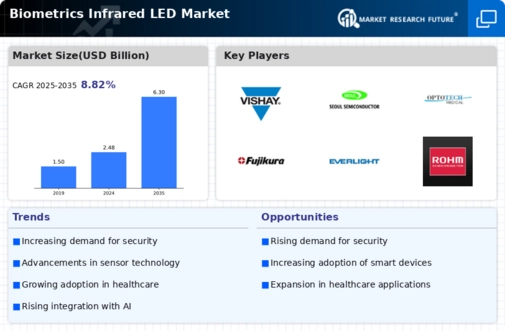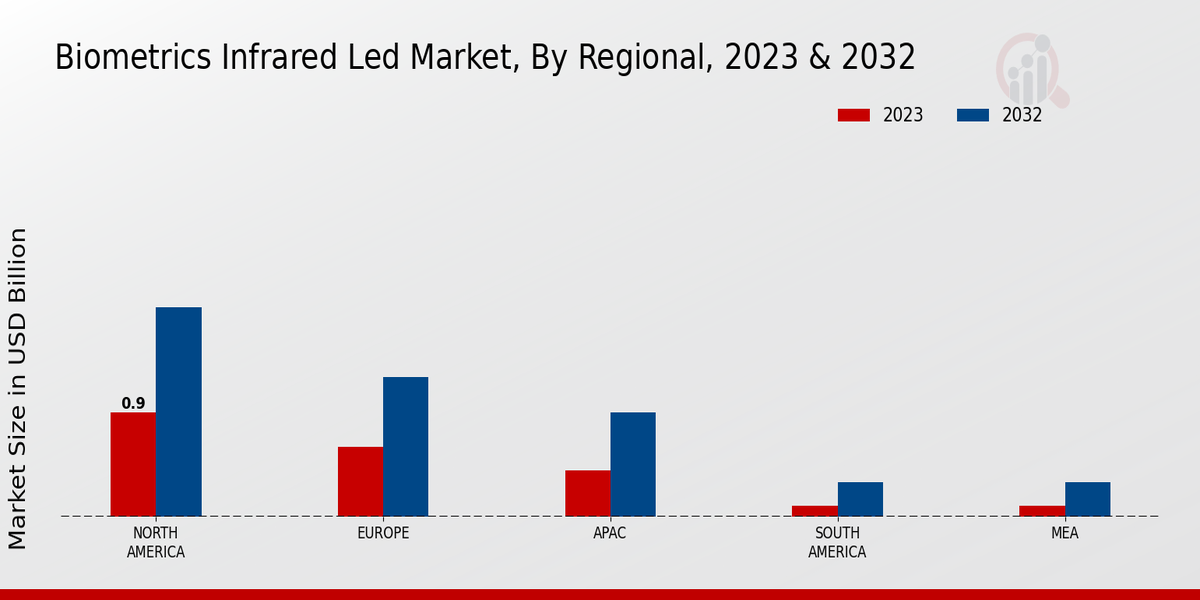Regulatory Compliance and Standards
Regulatory frameworks and compliance requirements are influencing the Global Biometrics Infrared LED Market Industry. Governments worldwide are implementing stringent regulations to ensure data protection and privacy, which necessitates the adoption of biometric systems. For example, the General Data Protection Regulation (GDPR) in Europe has prompted organizations to adopt secure biometric solutions to safeguard personal data. This regulatory push is likely to drive market growth as companies seek to comply with these standards. The anticipated compound annual growth rate (CAGR) of 8.85% from 2025 to 2035 underscores the importance of regulatory compliance in shaping the future landscape of biometric technologies.
Growing Demand for Security Solutions
The increasing need for advanced security solutions is a primary driver of the Global Biometrics Infrared LED Market Industry. As organizations and governments prioritize safety, the adoption of biometric systems, including facial recognition and fingerprint scanning, has surged. This trend is evident in various sectors, such as banking and healthcare, where security breaches can have severe consequences. The Global Biometrics Infrared LED Market is projected to reach 2.48 USD Billion in 2024, reflecting the urgency for enhanced security measures. The integration of infrared LEDs in biometric devices enhances accuracy and reliability, making them indispensable in modern security frameworks.
Rising Adoption in Consumer Electronics
The proliferation of biometric technologies in consumer electronics is a significant driver of the Global Biometrics Infrared LED Market Industry. Devices such as smartphones, laptops, and smart home systems increasingly incorporate biometric authentication features, enhancing user convenience and security. For instance, facial recognition and fingerprint scanning are now standard in many high-end smartphones. This trend is expected to continue as consumers demand more secure and user-friendly devices. The integration of infrared LEDs in these applications not only improves performance but also contributes to the overall growth of the market, reflecting a shift towards biometric solutions in everyday technology.
Technological Advancements in Biometrics
Technological innovations play a crucial role in propelling the Global Biometrics Infrared LED Market Industry forward. The development of more sophisticated infrared LED technologies has improved the performance of biometric systems, enabling higher accuracy and faster processing times. For instance, advancements in multispectral imaging and 3D facial recognition are becoming increasingly prevalent. These technologies not only enhance user experience but also expand the applicability of biometric systems across various industries. As a result, the market is expected to grow significantly, with projections indicating a rise to 6.3 USD Billion by 2035, driven by continuous innovation and the demand for cutting-edge security solutions.
Increased Investment in Smart City Initiatives
The rise of smart city initiatives is fostering growth in the Global Biometrics Infrared LED Market Industry. Governments and urban planners are increasingly investing in smart technologies to enhance public safety and improve urban living. Biometric systems, powered by infrared LEDs, are being deployed in various applications, including surveillance, access control, and identity verification. These initiatives aim to create safer and more efficient urban environments. As cities evolve into smart ecosystems, the demand for reliable biometric solutions is expected to escalate, further driving market growth and innovation in the coming years.





















Leave a Comment